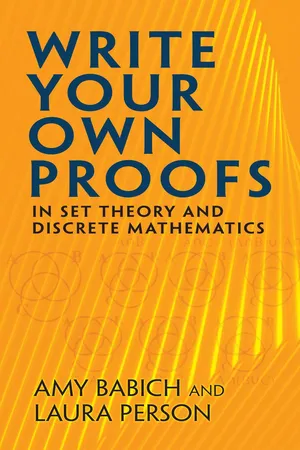
- 256 pages
- English
- ePUB (mobile friendly)
- Available on iOS & Android
About this book
Written by a pair of math teachers and based on their classroom notes and experiences, this introductory treatment of theory, proof techniques, and related concepts is designed for undergraduate courses. No knowledge of calculus is assumed, making it a useful text for students at many levels. The focus is on teaching students to prove theorems and write mathematical proofs so that others can read them.
Since proving theorems takes lots of practice, this text is designed to provide plenty of exercises. The authors break the theorems into pieces and walk readers through examples, encouraging them to use mathematical notation and write proofs themselves. Topics include propositional logic, set notation, basic set theory proofs, relations, functions, induction, countability, and some combinatorics, including a small amount of probability. The text is ideal for courses in discrete mathematics or logic and set theory, and its accessibility makes the book equally suitable for classes in mathematics for liberal arts students or courses geared toward proof writing in mathematics.
Frequently asked questions
- Essential is ideal for learners and professionals who enjoy exploring a wide range of subjects. Access the Essential Library with 800,000+ trusted titles and best-sellers across business, personal growth, and the humanities. Includes unlimited reading time and Standard Read Aloud voice.
- Complete: Perfect for advanced learners and researchers needing full, unrestricted access. Unlock 1.4M+ books across hundreds of subjects, including academic and specialized titles. The Complete Plan also includes advanced features like Premium Read Aloud and Research Assistant.
Please note we cannot support devices running on iOS 13 and Android 7 or earlier. Learn more about using the app.
Information
Chapter 1
Basic Logic
Table of contents
- Cover
- Title Page
- Copyright Page
- Dedication
- Contents
- Foreword A: This Book and How to Use It
- Foreword B: Words and Numbers: Mathematics, Writing, and the Two Cultures
- Foreword C: Mathematical Proof as a Form of Writing
- Foreword D: Amazing Secrets of Professional Mathematicians REVEALED!!!
- Credits
- Acknowledgments
- 1 Basic Logic
- 2 Proving Theorems about Sets
- 3 Cartesian Products and Relations
- 4 Functions
- 5 Induction, Power Sets, and Cardinality
- 6 Introduction to Combinatorics
- 7 Derangements and Other Entertainments
- Afterword A: A Few Words on the History of Set Theory
- Afterword B: A Little Bit About Limits
- Afterword C: Why No Answers In The Back of the Book?
- Afterword D: What next? Concise Synopses of Selected College Mathematics Courses
- Dr. Spencer’s Mantra for the Relief of Anxiety that Accompanies Attempts to Create and Write Proofs
- List of Symbols
- Bibliography
- Index
- About the Authors